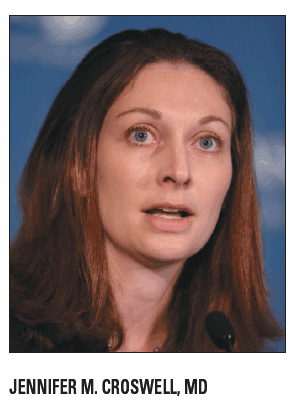False positives frequent in CT lung cancer screening trial
ORLANDO-Low-dose CT lung cancer screening carries a high burden of false-positive results after only two rounds of testing, according to research by NIH investigators.
ORLANDO-Low-dose CT lung cancer screening carries a high burden of false-positive results after only two rounds of testing, according to research by NIH investigators. CT screening for lung cancer has been marketed to the public without any clear evidence that it is beneficial, said study leader Jennifer M. Croswell, MD.

“We’ve seen some increasing promotion of low-dose CT scans as a lung cancer screening tool to the public,” she said during an ASCO 2009 press conference.
“This is mostly being done by individual hospitals and some advocacy organization groups ... suggesting that the value of these scans is to alleviate anxiety among smokers and former smokers. We don’t have good evidence that if you screen, you’ll actually see a reduction in lung cancer deaths.”
Dr. Croswell and colleagues from the National Institutes of Health and the National Cancer Institute in Bethesda, Md., sought to estimate the cumulative risk of an individual receiving at least one false-positive screening result. They also looked at whether these false positives promoted invasive procedures.
The researchers analyzed data from a feasibility pilot study that was performed before the ongoing National Lung Screening Trial was launched. The NLST enrolled 3,190 participants who had baseline CT scans or chest x-rays followed by one repeat annual scan. The subjects, both current and former smokers, were followed for one year after final screening.
A scan was deemed a false-positive result if it led to a completely negative workup or more than 12 months of follow up with no cancer diagnosis (abstract CRA1502).
Using Kaplan-Meier analysis, Dr. Croswell’s group determined that the cumulative probability of at least one false-positive test for an individual was 21% (95% confidence interval, 19% to 23%) after one screening study and 33% (95% CI, 30% to 35%) after the second screening test.
On multivariable analysis, higher odds of false-positive results were associated with increased study participant age (64 years and older).
The investigators also analyzed the diagnostic follow up for false-positive findings and noted that 61% of those participants with false-positive results on low-dose CT scan had to undergo additional imaging. Another 6.6% underwent invasive procedures.
Dr. Croswell said that physicians and patients should discuss the cumulative risk for false-positive results.
"Given that we see such a high burden of false positives with low-dose CT lung cancer screening, we feel that careful investigation of the physical, psychological, and economic ramifications is warranted," she said.
Commentary
Press conference moderator Julie R. Gralow, MD, commented that the true value of any cancer screening test is an improvement in mortality.
"We haven't seen that in screening for lung cancer yet. We'll accept some improvement in morbidity, but the gold standard is fewer deaths due to finding cancer earlier," said Dr. Gralow, who is the director of breast medical oncology at the Seattle Cancer Care Alliance, University of Washington.
"We need to wait for the NLST results so that we can see whether there is a survival benefit. If there is, then we'll accept a certain number of falsepositive results.," she said.
Dr. Gralow added that the medical community needs to focus on smoking cessation and nicotine addiction and not just rely on early detection to reduce lung cancer mortality.
Newsletter
Stay up to date on recent advances in the multidisciplinary approach to cancer.